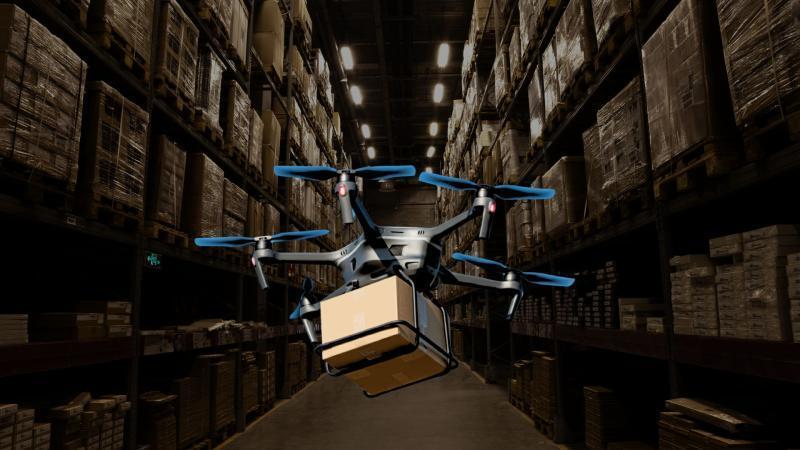
New Tech Optimises Drone Fleets for Faster, Greener Deliveries
The future of logistics is taking to the skies, and it’s about to get a whole lot greener. Researchers have developed a novel algorithm that tackles the “Drone Warehouse Problem,” a crucial challenge in managing drone fleets for efficient and sustainable last-mile delivery solutions.
The rise of e-commerce has put immense pressure on traditional logistics systems, with companies scrambling to find innovative ways to speed up delivery times while reducing their environmental footprint. Drone technology has emerged as a promising solution, offering the potential to cut delivery times and carbon emissions. However, managing a fleet of drones requires sophisticated logistics and scheduling, a challenge that has been dubbed the “Drone Warehouse Problem.”
The problem lies in the complexity of managing multiple drones, each with its own unique characteristics, such as speed, range, and capacity. Traditional logistics systems are designed for human-operated vehicles, not autonomous drones, making it difficult to optimize drone flight schedules and routes. This can lead to inefficiencies, increased costs, and, most importantly, longer delivery times.
Enter the novel algorithm developed by researchers, which addresses the Drone Warehouse Problem by optimizing drone delivery schedules. This breakthrough technology enables warehouses to efficiently manage varied drone fleets, ensuring that parcels reach customers quickly and reliably.
The Algorithm in Action
The algorithm, known as the “Drone Fleet Scheduling Algorithm” (DFSA), uses advanced machine learning and optimization techniques to create the most efficient drone flight schedules. By analyzing factors such as drone capacity, weather conditions, and traffic patterns, the algorithm creates a customized flight plan for each drone, ensuring that each delivery is made with the least amount of fuel and time.
Here’s how it works:
- The algorithm collects data on the drone fleet, including their capabilities, maintenance schedules, and current locations.
- It analyzes the data to identify the most suitable drone for each delivery, taking into account factors such as speed, range, and capacity.
- The algorithm then creates a customized flight plan for each drone, ensuring that each delivery is made with the least amount of fuel and time.
- The flight plans are continuously updated in real-time to account for changing weather conditions, traffic patterns, and other factors that may impact drone flight.
Benefits of the Algorithm
The Drone Fleet Scheduling Algorithm offers several benefits for logistics companies, including:
- Faster Delivery Times: By optimizing drone flight schedules, the algorithm ensures that parcels are delivered quickly and efficiently, reducing the time it takes for customers to receive their packages.
- Reduced Carbon Emissions: By using drones, which are electric or hybrid, the algorithm helps reduce carbon emissions, making logistics more sustainable.
- Increased Efficiency: The algorithm reduces the complexity of managing a drone fleet, allowing logistics companies to focus on other aspects of their business.
- Improved Customer Experience: With faster delivery times and real-time tracking, customers can expect a more seamless and enjoyable experience.
The Future of Logistics
The Drone Fleet Scheduling Algorithm is a significant step towards scalable, sustainable last-mile delivery solutions. As the demand for e-commerce continues to grow, logistics companies will need to find innovative ways to manage their fleets and reduce their environmental impact.
The algorithm’s potential applications extend beyond the logistics industry, with possibilities in fields such as:
- Emergency Services: Drones can be used to quickly deliver medical supplies, blood, and other critical items in emergency situations.
- Agriculture: Drones can be used to transport seeds, fertilizers, and other agricultural products to remote areas.
- Environmental Monitoring: Drones can be used to monitor and track environmental factors, such as air and water quality, in real-time.
Conclusion
The Drone Fleet Scheduling Algorithm is a game-changer for the logistics industry, offering a practical solution to the complex problem of managing drone fleets. With its ability to optimize drone delivery schedules, reduce carbon emissions, and improve customer experience, this technology has the potential to revolutionize the way we think about last-mile delivery.
As we look to the future, it’s clear that drone technology will play a critical role in shaping the logistics industry. With the Drone Fleet Scheduling Algorithm, we’re one step closer to making that vision a reality.
Source:
https://researchmatters.in/news/novel-algorithm-tackles-drone-warehouse-problem-faster-deliveries






